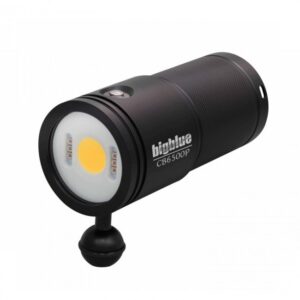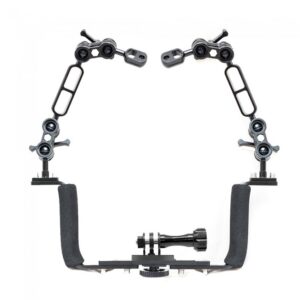Underwater video lights are a must for underwater videography. It is the key to grabbing the best quality content. So you must wonder, what is a great quality underwater video? Can I get great videos with just a GoPro?
The secret lies in grabbing the true colors of what you are shooting. To have video footage that is closest to real life. That’s why I often say that your lights are more important than your camera!
So let us dive right in and cover everything you need to know for underwater video lights!
The difference between underwater video lights and photo
Underwater photography is more common than underwater videography, therefore we know much more about UW photo lights (strobes) than underwater video lights (constant LED lights).
The aim of both lights is the same. To keep it simple, it is to light up what you are shooting. Strobes will shoot out a one-off flash of light when the picture is being taken. On the other hand, underwater video lights provide a constant output of light. It is this output of light that allows continuous recording of the video.
Now that that is out of the way, let’s have an in-depth look at underwater video lights.
Underwater video lights strength (lumens)
What is lumens?
To keep it simple, lumens equal brightness. A lumen is a unit of luminous flux in the International System of Units. It measures the amount of light given out from a solid angle by a source of one candela intensity radiating equally in all directions.
Lumens are different from watts as watts measures energy use whereas, as per above, lumens measure the light output.
How many lumens for underwater video lights?
The general rule of thumb is: the brighter the better; more lumens give a brighter light. We consider 2,500 lumens as being the minimum required and a good place to start. A mid-range brightness is anything above 5,000 lumens and is able to light up correctly an underlit scenery underwater. 10,000 and above is considered very powerful and is used by professional underwater videographers. It will allow you to light up an underwater scenery that is already well lit.
Hard or soft edges?
You need to have soft edges for your underwater video lights. Remember that what you want to achieve is a natural-looking shot, and hard edges will give this artificial light look to your footage.
What beam angle for underwater video lights?
The sought-for beam angle for underwater video lights is wide beams. This is a general rule of thumb and mainly applies to an all-around solution. The most important aspect of the beam angle of your UW video lights is that it covers the entire frame of the video you are shooting.
Beam angle for shooting wide videos
For shooting wide-angle (fish eye) videos like reefscapes, wrecks, and pelagic fish, you will need a floodlight type of underwater video light. The beam angle for UW wide videos is 120 degrees.
It is important to note that the wider the beam angle, the higher the amount of lumen required. Do not go for a wide-angle with low lumens!
Beam angle for shooting macro videos
Shooting macro videos, as you can imagine, requires the opposite type of underwater video lights than wide. That doesn’t mean that you absolutely can’t shoot UW macro videos with wide-angle video lights.
Using a wide beam angle for shooting underwater macro videos defies the point of macro videography though. And that is to have the focus on the subject. The wide beam will light up the whole scene and lose that focus.
A focus type of beam angle is used for underwater macro videos. The beam angle degree for UW macro videos is 90 degrees. The beam angle of the UW macro light is narrow, therefore only focusing on the subject putting it in the spotlight.
Please note that contrary to the wide-angle light, the focused light needs much less lumen as it is focused into a tight beam. The light on a macro beam can also light up some of the animals surrounding background. This is most likely the case for the tiniest of creatures like nudibranchs and flatworms. In that case, you will need a snoot light.
Snoot light

A snoot light is the tightest beam available for underwater video lights. The snoot is a tube or similar object that fits over an underwater video light and allows the videographer to control the direction and radius of the light beam. So the snoot is not a source of light of its own but merely a tool to shape and tighten a light beam.
The snoot is used in many different depending on the need of the shooter. You can generally widen or tighten it either by rotation or by moving the source of light closer or further from the subject. The shape of the light on the surface can also be greatly changed by adjusting the angle at which the light is hitting the subject.
Using a snoot for underwater videography is one of the greatest challenges you will face underwater. It is very hard to keep your moving subject right under a tight beam. It makes you feel that nudibranchs had a Redbull before you started shooting!
Underwater video lights for night dives
Underwater video lights for night dives are the same as for those used during the day and use the same principles.
The only difference you will find for night dive underwater lights is that the normal LED lights attract swarms of critters. This is very annoying as it completely destroys your footage and quickly takes over all your personal space so to speak.
For night dives, I highly recommended targeting your subject using a red light. The red light won’t attract the swarm of critters. You can then switch your light to ‘normal’ and shoot.
Color Temperature and Rendering Index
The color temperature (CCT) and Color Rendering Index (CRI) of your underwater video lights are crucial to shooting underwater videos. This is because it will give footage that is truest to reality.
Underwater video lights Color Temperature
The color temperature of the light emitted by your UW lights is expressed as Correlated Color Temperature (CCT). The CCT refers to the color or warmth of the light and is measured in degrees Kelvins. It gets confusing because cooler CCTs are higher and warmer CCTs are lower in Kelvin values.
To keep it simple, the sun or daylight has a CCT ranging between 5,500 and 6,000 K and that is what you should be aiming for in your underwater video lights. If you think about it, it makes sense. True colors are the colors we see under the light of the sun.
Underwater video lights Color Rendering Index

The Color Rendering Index (CRI) is another important factor when it comes to shooting quality underwater videos. The CRI measures how accurately the light source is rendering all frequencies of the color spectrum.
Simply put, the higher the CRI value of your light, the more accurate the true color of the object will be. A rule of thumb is any underwater video lights with a CRI above 80 are good, and anything above 90 is excellent.
How many underwater video lights do you need?
You should always aim for two UW video lights. Simply put the minimum of two lights is crucial for balancing your camera system underwater more than anything. The correct balance of your system will ensure your correct balance in the water column. Never forget that the most important thing when filming underwater videos is your safety and that of your buddy!
Number of underwater lights for wide videos
When shooting wide videos (generally with a fisheye), you need to have a minimum of two UW video lights. That is easily justified by the idea expressed above when we talked about beam angles. When you have two UW video lights placed on your system, it allows you to flood the whole scenery with light.
Number of underwater lights for macro video
You may be inclined to think that the best number of lights for shooting UW macro videos is two lights. But it’s not. Yes, you primarily use one light focused on your subject when shooting macro. But this doesn’t take into account balancing your system, light failure, and flexibility.
Therefore, you need two UW video lights for shooting UW macro videos. Let me explain! Yes, you can go about with only one light, and if your budget only allows for one really good light versus two mediocre ones, do go for one light to start with.
Having two lights first of all will create a good balance underwater for your camera system. Furthermore, it will allow for great flexibility. You can have the light on the right equipped with a snoot and that on the left as a normal macro light with potentially color filters options attached to it. Having two lights also makes a world of difference when one of your lights dies on you because of failure or not being charged enough.
Number of underwater lights for a hybrid macro/wide video setup
This is my perfect setup! Two wide beam lights on the side and one dedicated macro light in the middle for macro opportunities or vice versa. Now, you may be wondering how it can be possible to have such a hybrid system. If you want to know more about this setup, stay tuned for the upcoming article on the perfect underwater camera setup!
Underwater video lights placement
Your underwater video lights placement is crucial to the quality of your footage, especially when it comes to editing in post. Having unwanted shadows on your underwater footage can destroy its whole potential.
UW video lights placement for wide-angle
Follow the following rules for the perfect underwater video lights placement for wide-angle:
- Direction: UW lights always facing forward, never inward. This will make sure the light is spread evenly;
- Distance: keep your lights at equidistance of one another for the right balance and light spread. When you move closer to the subject move them closer to the housing, and vice versa when moving away;
- Angle: place your underwater video lights at a higher level than your lens. Remember that natural light always comes from above;
UW video light placement for macro
When shooting macro videos, you will be using one focused light. It is important to be able to move that light around in order to have the desired focus. You cannot and should not have a fixed light for UW macro video. You may want to focus on the eyes, mouth, general expression, etc. of your subject when it is facing you. Therefore, you need to move the focus of your light to achieve that. Though, as a general rule of thumb, you always want the light to come from above or at least an angle from above.
Check out some of our macro video samples on our gallery.
Best underwater video lights for GoPro
Best UW video light
BIG BLUE CB6500P – BUY ON HOUSING CAMERA
Best UW video light bundle
GOPRO TRAY AND LIGHT BUNDLE – BUY ON HOUSING CAMERA
Best GoPro hybrid macro/wide setup
GOPRO TRAY WITH ARMS – BUY ON HOUSING CAMERA
BACKSCATTER MACRO WIDE 4300 – BUY ON HOUSING CAMERA
FLIP 8/9/10 PRO – BUY ON HOUSING CAMERA
Best professional wide-angle underwater video lights
BIG BLUE CB15000P – BUY ON HOUSING CAMERA
Best underwater macro and hybrid video lights
BACKSCATTER MACRO WIDE 4300 – BUY ON HOUSING CAMERA








